

Unkover your competitors’ Marketing Secrets
Say goodbye to wasting hours on competitor analysis by equipping your team with an AI-driven, always-on competitive intelligence platform.


Say goodbye to wasting hours on competitor analysis by equipping your team with an AI-driven, always-on competitive intelligence platform.

Stay Ahead with AI-DRIVEN Competitive Intelligence
Unkover is your AI-driven Competitive Intelligence team delivering critical updates about your competitors the moment they happen:
Track your competitors website changes
Why spend all day stalking the competition when you don’t have to?
With Unkover, you’ll know instantly when your competitors tweak their messaging or shake up their pricing. No more endless scrolling through their sites or second-guessing your strategies.
Let us do the heavy lifting for you, ensuring you’re always in the loop by notifying you the moment a critical change happens on your competitor’s pages.
Sit back, relax, and keep winning—Unkover makes sure you’re not just in the game, you’re always a step ahead.


Read your competitors emails
Companies love updating their customers and prospects about relevant news, product updates, and special offers.
That juicy info from your competitors? It’s yours too. Unkover will automatically capture all their emails and bring them right to your doorstep—accessible to your entire team, anytime.
[COMING SOON: Our fine-tuned AI will sift through these emails, extract key information and send them over to the best team within your org. Less noise, more signal!]
We hear you! Unkover’s goal is not to flood you with tons of data points that no one in your team will ever read. We gather competitive intelligence from thousands of data sources and use AI to highlight actionable information to the right team in your company.
Say goodbye to noise. We’re 100% signal.
ROADMAP
We’re excited to get Unkover in your hands as soon as possible and keep building the best competitive intelligence tool with your precious feedback. The roadmap for the next few months is already exciting, so take a look!
While we build and deliver, here’s our promise to you: as an early tester and customer, you’ll lock in an exclusive bargain price we’ll never offer again in the future.

Spy on your competitors’ full marketing strategy: social, ads, content marketing, email flows, and more.

Track competitive Win/Loss analysis and build battle cards. Get alerted at every pricing change.

Get immediate alerts when competitors announce new features or major releases. Identify strengths and weaknesses from online reviews.

Get the competitive intelligence you need where you need it: Slack, eMail, MS Teams, Salesforce, Hubspot, Pipedrive and more.
slack integration
Unkover’s Slack integration lets you keep your whole team up to speed with your competitors’ updates.

Join now to lock in an exclusive 50% lifetime discount
For startups and small teams, it’s the essential toolkit you need to keep an eye on a select few competitors.

Up to 5 competitors

50 pages monitored

10 email workflows

3-day data refresh
$39
/per month
$ 79
50% discount
Billed annually
For growing businesses, it allows you to monitor more competitors, pages, and email workflows.

Up to 10 competitors

100 pages monitored

20 email workflows

1-day data refresh
$79
/per month
$ 159
50% discount
Billed annually
For large companies, it is tailored to meet the needs of multiple teams needing granular insights.

Custom number of competitors

Custom number of pages monitored

Custom number of email workflows

Hourly data refresh
Custom price
Billed annually

Your sales stack is the marketing and sales technology that you have in your arsenal designed to help you attract new clients and sell more to existing ones.
And now, at the end of 2023 and as we approach 2024, we’ve got tools at our fingertips that would have been almost unfathomable a decade ago. There are so many SaaS tools out there that can help you drive sales by offering features, including tracking customer data, setting up demos, offering custom discounts, and more.
With so many tools on the market, knowing which tech you need in your sales stack is more important than ever before. In this post, we’re going to take a look at nine types of tools you need in your sales stack and share our go-to recommendations for each.
Your CRM will be everything, and many will either integrate with other tools on this list or actually come with some of the other tools attached.
A CRM will store all of your contacts (including leads and customers) and track and review their entire history. See users who have engaged with your site, opened emails, booked an appointment, or purchased recently. You can use all of this information to provide outstanding support and personalized sales recommendations.
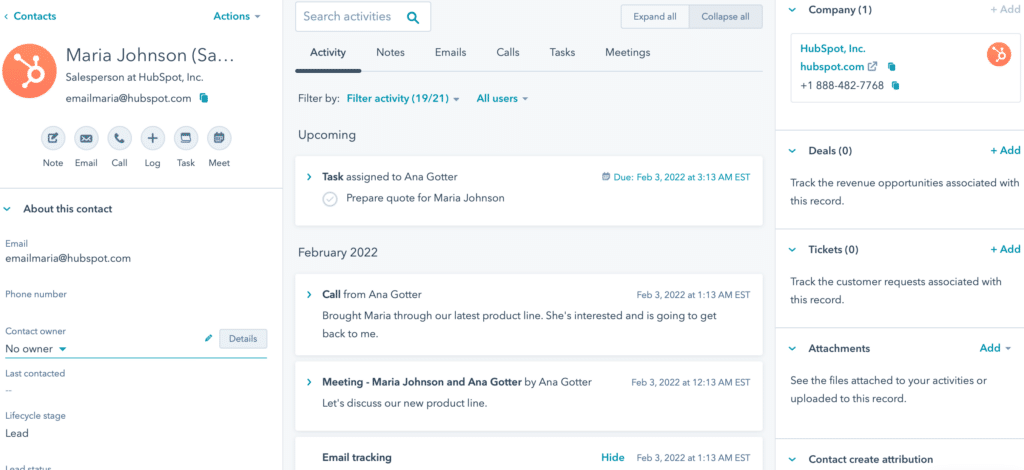
Sales Stack Tool Recommendation There are plenty of great CRMs on the market, but my go-to choice is HubSpot. It’s incredibly intuitive, it walks you through the setup process, and it scales up and down well. It has plenty of great features at every plan level, and a number of advanced features as you increase your plan cost. Salesforce is also a great option (and it’s our top sales-first software, which we’ll discuss in the next section).
In many cases, your CRM will overlap with sales-facilitating and analytics software, but because they can be separate we wanted to have them listed separately here, too.
Sales software and analytics will focus entirely on helping your brand to find opportunities to sell more. Features typically are going to include the following:
This is one of the most important sales categories out there, so it’s important to choose a tool that works for your entire team.
Sales Stack Tool Recommendation Salesforce is easily the top sales-focused tool on the market right now. They have more advanced and customizable features, which is why it’s regarded as one of the top industry tools right now. Salesforce can get pricey, so if you need a more budget-friendly tool, HubSpot is comparable here with their features (especially once you get into their paid plans).
Contact scoring tools—also sometimes called “lead scoring tools”—serve a very distinct and more singular purpose compared to the two tools we’ve looked at so far for your sales stack.
These tools look at individual contacts and give them a score based on factors like their company demographics, onsite engagement, and other activity with your brand. These scores help your sales team identify high-value leads, but they can also help you determine upselling or cross-selling opportunities, too.
Sales Stack Tool Recommendation It goes without saying that Breadcrumbs is our go-to choice here. We use a unique co-dynamic approach to contact scoring that no other tools can compare to, giving you both a fit score and an activity score for each contact. Our system also has templates for different models, like upselling or cross-selling models, that are fully customizable so your sales team has all the actionable information they need. Learn more about how this works here.
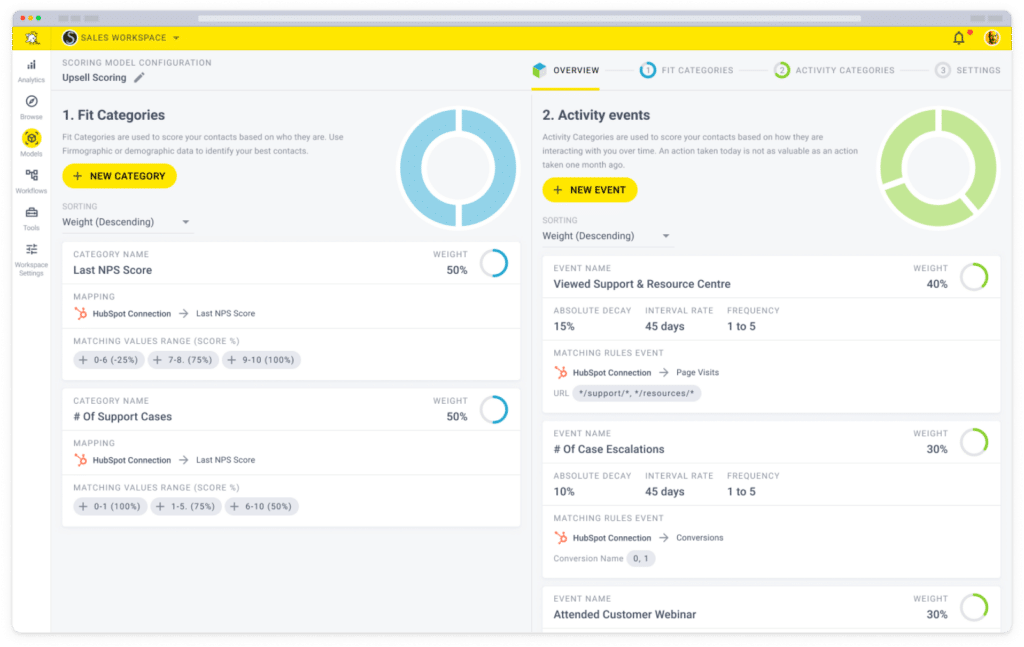

Salesforce is one of the most high-powered sales and CRM-focused SaaS tools on the market…
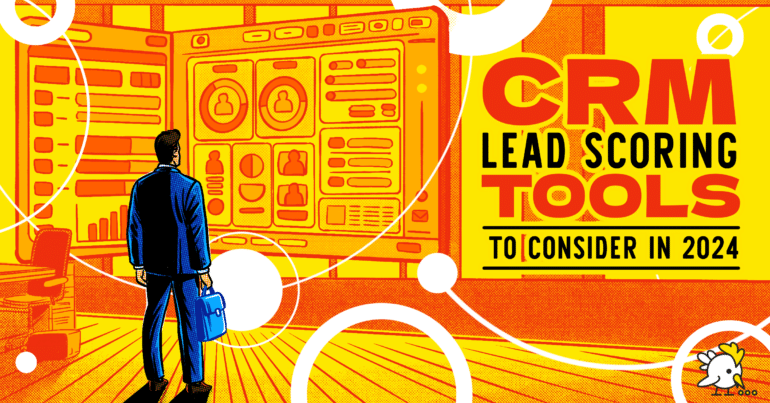
Every good sales team needs a great customer relationship management (CRM) tool backing them up. …
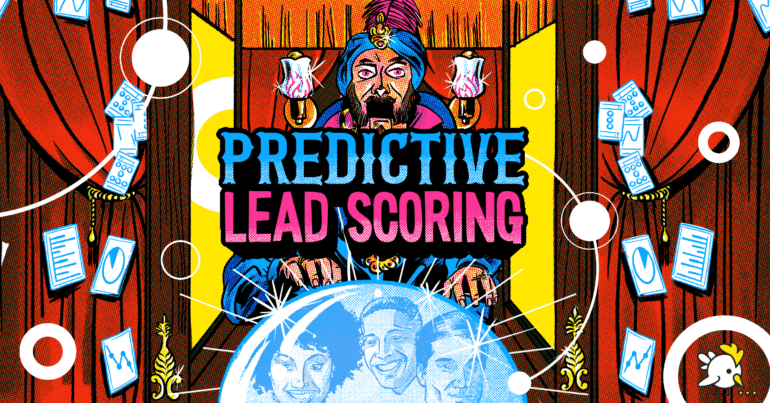
Over the past decade, we’re sure that you’ve noticed that your marketing tech stack options…
Lead generation and prospecting tools are a category of tools that can help you find new prospects to reach out to and capture information about contacts that you’ve already identified.
The more leads you have, the better, and the more data you have about those leads, the better. These tools can give your sales team new opportunities for outreach, giving them the ability to get in touch instead of waiting for leads to come to them. The data they pull from these tools can also help them create custom sales pitch decks and deals to increase the chance of conversion, especially if they’re opting for account-based marketing.
Sales Stack Tool Recommendation There are a variety of tools that we’d recommend for this purpose, including the following: - Cognism - Apollo - LinkedIn Sales Navigator - LeadFuze - UpLead - Uniqode You can also just use the standard LinkedIn platform for networking purposes. In many cases, using a combination of different tools may give you the best reach and the most thorough information.
The sales world moves fast, and especially as your team grows, your sales team has so much on their plates at any given moment. As a result, they don’t have to check in on ten different platforms every day or log in to see if there are new leads from Facebook.
Instead, your team needs to rely on fast, immediate, and automatic data syncing. This is where automation tools come into place.
There are plenty of integration-heavy automation tools that will help your sales team streamline their processes. All your social media messages could come through your CRM, for example, or when users open an email, you can craft a follow-up instantly.
Sales Stack Tool Recommendation There are plenty of automation tools out there, and some CRM or sales-focused platforms come with automation features. That being said, my preferred tool is Zapier. They have thousands of different integrations, it’s easy to use, and you can create custom Zaps to create your own workflows.
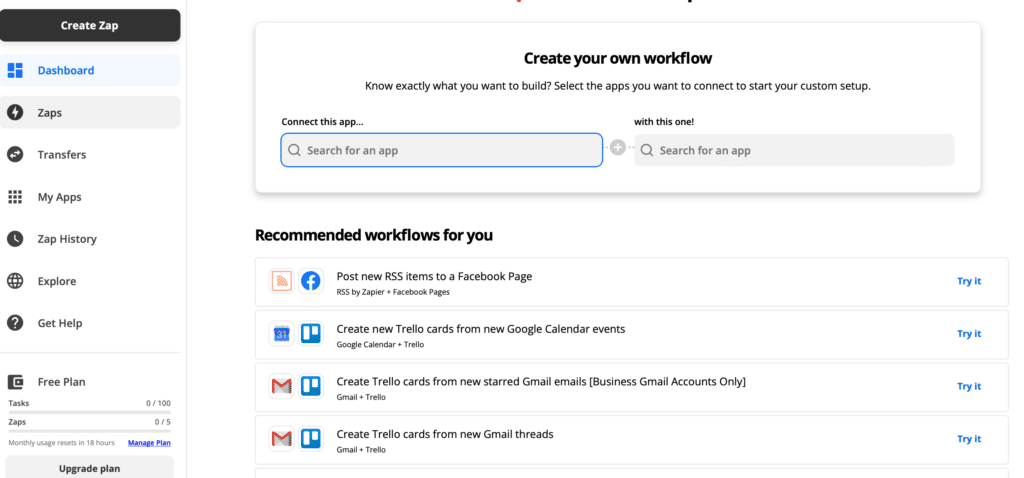
Appointment-booking and demo-booking software should be a go-to for all brands, but it’s often overlooked as a tool for your sales stack.
An appointment booking system can be integrated into your site for demo or sales call booking. You can also have individual calendars for each of your sales team members, which they can link to in their email signatures. This makes it easy for your team to manage their own calendars and for your customers to get in touch as needed.
Sales Stack Tool Recommendation
Calendly is one of the easiest scheduling tools on the market to use. They allow you to customize your schedule, blocking out times when you aren’t available and setting time limits or meeting types to give you control over your schedule even while you automated it.
You’ll get meeting reminders, and the person you’re meeting with will, too.
Calendly also integrates with other tools, so you don’t have to just stick to a phone call; you can also set up Zoom calls, too. And best of all, paid plans start at just $8 per month, making this an easy add-on feature that won’t break the bank for any budget.
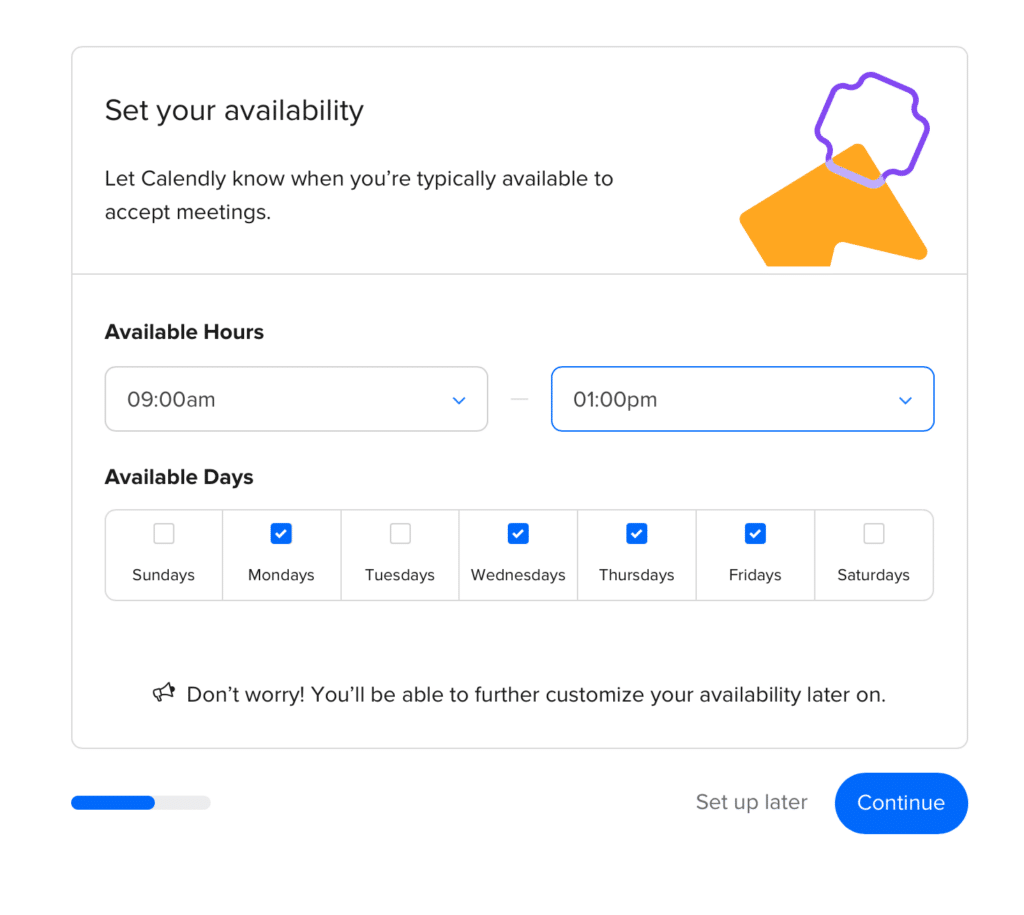
Last but not least, we strongly recommend that sales teams of all sizes implement live chat tools.
More and more customers are turning to live chat when they have a question or concern, so having live chat functions on your site will increase the likelihood that they’ll get in touch and thus convert. It gives your customers one more way to get in touch and your sales team one more opportunity to close a deal.
Plenty of live chat tools will actually integrate your on-site live chat messages alongside your brand’s social media private messages so that your team can respond all in one place.
Sales Stack Tool Recommendation There are plenty of live chat tools out there, and the best ones really depend on your specific business. Drift is a solid choice, no matter what your specific needs are. It’s designed to help you create improved sales pipelines. It’s easy to set up, customize, and integrate with third-party tools. It also comes with plenty of features like analytics, conversational AI tools for fast responses and navigation menus, and lead qualification. It's a great choice for a live chat tool that's both customer- and sales-friendly.
Outreach through cold emailing is one of the most valuable lead generation and prospecting techniques out there. You can create lists of potential prospects and then message them at scale, ideally while maintaining the kind of personalization needed for account-based marketing.
Email software that’s designed for cold email outreach is essential for many sales teams, especially those with sales development representatives (SDRs) who are heavily involved in prospecting.
Sales Stack Tool Recommendation Hunter is an excellent choice for scaling your cold email outreach, offering an all-in-one solution for sales teams. It enables the discovery of valid email addresses of prospects, the building of segmented lead lists, and the creation of personalized cold email campaigns at scale. As a sales team leader, you can track your team's performance, understand what works well, and identify areas for improvement. A standout feature is the unified inbox, which allows your team to manage multiple inboxes from a single dashboard.

Sales forecasting and pipeline management software are sometimes included with CRM or sales tools like Salesforce, but they can also be found as specialized standalone tools.
This software is designed to help you track current prospects and leads who are in your pipeline and to help you estimate how many sales you’re likely to close based on your current pipeline, past trends, and other factors impacting your business.
For this software, make sure you’re choosing a tool that’s known for reliability and accuracy. You also want to pick a tool that ideally integrates with your CRM and deal-tracking software, and that is able to account for your specific business model.
If, for example, you sell subscription products, you want to choose a tool that’s designed for subscription sales.
Sales Stack Tool Recommendation The ideal sales forecasting and pipeline management tool will depend based on your business type and your existing tech stack. If, or example, you’re already using Salesforce, using their pipeline tracking and forecasting tools makes sense. And if you’re an SaaS subscription business, tools like Baremetrics Forecast are worth considering, as they specialize in sales forecasting for subscription companies based on active subscribers and current revenue trends. Other tools worth considering include: - Pipedrive - Weflow - InsightSquared
Conversation intelligence tools are sometimes lumped in with more general sales intelilgence tools, but this is such a specific niche that’s so valuable it deserves its own section.
Conversation intelligence software uses AI and machine learning to comb through your communications with customers across various platforms (including live chat, phone call, and email) to look for advanced insights. You may get customer sentiment data, for example, or suggestions for how to close more deals or improve call performance.
These tools are invaluable for sales teams, allowing you to optimize performance and train your sales teams well.
Sales Stack Tool Recommendation Gong is the most common and well-known conversation intelligence tool. It will analyze most communication platforms to provide insights in near-real-time so your team can adapt and pivot quickly. They provide sentiment analysis, key phrase trends, workflow suggestions, and forecasting features. The tool is widely respected.
Sales teams want to be ready to send over proposals and contracts the second that a client is ready to sign— striking while the iron is hot, and all that.
Deals and proposal software can not only help you look professional, but it also streamlines the onboarding process and significantly increases the likelihood of onboarding completion.
Most deal and proposal softwares include features like the following:
Sales Stack Tool Recommendation Some CRM tools may come with native deal or proposal features included. If your CRM plan does not include this, these tools are great go-tos: - Proposify - DealHub - Loopio - PandaDoc
As you’re building a sales stack for your team, a good first step is to take a look at the tools that you’re already using. This will (and absolutely should) determine which tools you’re adding.
If you already have some tools and are looking to build to your stack, you want to find additional tools that do the following:
If you’re starting from scratch, make a list of the specific needs you have and what types of software that can help. Specifically, focus on the features that you need and how you plan to use the software. This can help you narrow things down while fitting it all into a budget.
Some CRMs, for example, automatically include sales forecasting or data enrichment features at higher-level plans, and it may be cheaper to use a single tool for multiple purposes as long as it has the advanced features you need.
Most tools either offer free trials or free demos, so you can be confident that you’re finding the tech that works best for your brand and your sales stack to get you a few steps closer to Revenue Acceleration.
Ready to add a contact and lead scoring tool to your sales stack? Book your free demo of Breadcrumbs here.